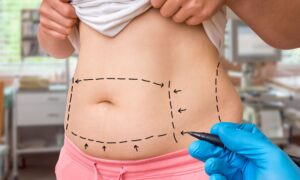No matter how committed you are to your diet or exercise routine, some areas of fat just don’t seem to go away. These stubborn pockets—like love handles, under-chin fat, or inner thighs—can be incredibly frustrating, especially when they affect how you feel in clothes or how your body looks in photos.
That’s where liposuction comes in. This popular cosmetic procedure is not a weight-loss tool but a highly effective method for reshaping and contouring specific areas that resist change. Whether you’re looking to slim your waist, sculpt your arms, or redefine your jawline, liposuction can offer targeted, lasting results.
In this post, we’ll cover how liposuction works, which areas it treats best, who it’s right for, and what to expect before and after the procedure—so you can make an informed and empowered decision.
What Is Liposuction?
Liposuction is a surgical procedure designed to remove localized fat deposits from specific areas of the body. It works by inserting a thin tube (called a cannula) through small incisions in the skin, then using suction to extract excess fat cells from beneath the surface.
The procedure can be performed under local anesthesia with sedation or general anesthesia, depending on the size and number of areas being treated. Over the years, liposuction has evolved significantly, with modern techniques such as tumescent liposuction, power-assisted liposuction (PAL), and ultrasound-assisted liposuction (UAL) improving both precision and recovery.
Importantly, liposuction is not a weight-loss solution. Instead, it’s best suited for individuals who are close to their ideal weight but have specific trouble spots they want to address. When performed by a skilled, board-certified plastic surgeon, it offers a safe and effective way to refine your figure.
Most Common Stubborn Areas Treated
One of the reasons liposuction remains so popular is its versatility. It can target a wide range of stubborn areas, including:
- Abdomen and flanks: Commonly treated to eliminate belly fat and love handles, creating a smoother, more defined midsection.
- Thighs: Inner and outer thighs can be reshaped for improved leg contour and less chafing.
- Chin and neck: Liposuction here can reduce a double chin and enhance the jawline.
- Upper arms: Helps reduce “bat wings” and firm the appearance of the arms.
- Back and bra rolls: Smooths out areas that often bulge under tight clothing.
- Knees and calves: Refines leg shape and balance.
Liposuction can be performed on one or several areas at once, depending on your goals. An experienced surgeon, such as one in Beverly Hills, for example, will tailor the treatment plan to your body type and desired outcome, ensuring natural-looking, harmonious results.
Are You a Good Candidate?
While liposuction is highly effective, it isn’t the right choice for everyone. The ideal candidates are individuals who:
- Are within 10–20 pounds of their goal weight.
- Maintain a relatively healthy lifestyle, including balanced eating and regular activity.
- Have firm, elastic skin—this helps the body conform smoothly to its new contours post-procedure.
- Have specific, localized fat deposits that don’t respond to diet or exercise.
- Are in good overall health, with no major medical conditions that could increase surgical risks.
Liposuction is not suitable for treating obesity or large areas of loose, sagging skin. In cases where skin laxity is a concern, patients might require a procedure like a tummy tuck or arm lift in addition to or instead of liposuction.
Equally important is mindset. You should approach liposuction with realistic expectations—it won’t create a completely new body, but it can enhance the shape you already have and make your proportions more flattering.
What to Expect: Procedure and Recovery
A liposuction session typically lasts 1 to 3 hours, depending on how many areas are treated. The procedure is performed in an accredited surgical facility, often on an outpatient basis, meaning you go home the same day.
Here’s what the process generally looks like:
- During surgery: The surgeon makes small incisions, inserts the cannula, and removes fat using gentle suction. Techniques like tumescent fluid (a saline solution with anesthetic and epinephrine) help reduce bleeding and pain.
- After surgery: Patients typically wear compression garments for several weeks to minimize swelling, support healing, and help shape the treated area.
- Recovery time: Most people experience swelling, bruising, and soreness for a few days to a week. Many return to work in 3–5 days and resume light exercise in 2–3 weeks. Strenuous activity should wait until cleared by your surgeon.
- Results: While some change is visible immediately, final results can take 3–6 months as swelling fully resolves and the body adjusts.
The Long-Term Results
One of the biggest advantages of liposuction is that fat cells removed during the procedure are gone for good. Once those fat cells are suctioned out, they don’t grow back. However, this doesn’t mean new fat can’t develop.
Here’s the catch: remaining fat cells can still expand if you gain weight. That’s why it’s important to maintain your post-lipo body through a stable weight, balanced nutrition, and regular exercise. When paired with healthy habits, liposuction results can last for many years.
Many patients find that the procedure acts as a motivator—it boosts confidence and encourages long-term body care. It’s not uncommon for people to feel more enthusiastic about fitness and more comfortable in their clothes (and in their own skin) after seeing their refined shape take form.
Liposuction vs. Non-Surgical Alternatives
In recent years, non-surgical fat reduction treatments like CoolSculpting, SculpSure, and Emsculpt have gained popularity. These methods use cold, heat, or electromagnetic energy to shrink fat cells over time.
While non-surgical options offer the benefit of zero downtime and no incisions, they come with trade-offs:
- Results take longer to appear—often several weeks or months.
- Multiple sessions are usually required.
- They are less effective for larger or deeper fat deposits.
- They typically can’t sculpt as precisely as liposuction.
Liposuction, on the other hand, removes fat immediately, allows for more detailed contouring, and is generally more predictable when performed by an experienced surgeon. It’s often a better choice for patients who want noticeable, one-time results or who have stubborn areas that haven’t responded to other methods.
Conclusion
If you’re struggling with areas of fat that won’t go away no matter how healthy your lifestyle is, liposuction may be the solution you’ve been searching for. It’s not about becoming someone else—it’s about refining your shape, reclaiming your confidence, and feeling more at home in your body.
By choosing a qualified, board-certified surgeon, setting realistic goals, and committing to long-term health habits, you can enjoy lasting, natural-looking results that elevate how you look and feel.



































